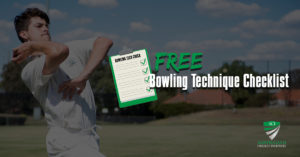We’ve spoken about how there is very little transference of how we train to how we play, bowling is one of the major ones.
Sometimes we bowl with 4 or 5 bowlers in one net, bowling once every 2 or so minutes for an extended period of time.
Not really much going on with developing plans, dealing with pressure, or an emphasis on how we train ourselves to build an over.
This is a 6 step guide on how to ensure that what you are doing at training can help influence your performance and consistency during game day.
- Give yourself a target
It may be bowling at a target on off stump, or causing the batsmen to only play the ball on the front foot.
Too many times I see bowlers just ambling in and bowling, no real emphasis on executing a particular delivery.
Advice: Every ball name the ball you are going to bowl before you start to run in and bowl. See if you can execute what you are wanting. Having a conscious target in mind (it may even be a physical one, hoop on net, target on stumps, bowlers shoe etc) you are more likely to execute or at least have a great chance to execute.
(Click above to download your free Fast Bowling Technique Checklist)
- Work Your Routine In
A big part in cricket is the ability to control your thoughts, feelings and emotions.
Use your time between balls to work on your between ball routine to ensure that your mind is clear of all negative thoughts and distractions.
Having a clear routine can help you with executing your skill and be consistent no matter the situation of the game.
- Train All Types Of Conditions
New ball, bowling in the power play, bowling with an old red ball, bowling in the middle overs of a one day game, or bowling at the death.
It’s vital that you train and bowl to mimic all types of conditions you are going to come up against that weekend.
No use bowling with a brand new hard ball, if you are bowling in the middle overs of a 1 day game.
Your lengths will be different depending on the stage of the game you bowl in and also your fields. Get used to adapting to these at training.
(Click Above to download your free Fast Bowling Technique Checklist)
- Work With Teammates To Develop Plans
A critical component in developing your knowledge of the game and exploring your bowling plans.
It’s a great time to work together as a group with your fellow bowling partners.
Develop plans to batsmen in the nets. Speak about how you are going to get them out, what are their weaknesses and look to create a plan on how to bowl to them.
Another great component of this is you actually get to learn and understand how your team mates bowl.
This is golden for when you are in a game, it’s critical that bowling groups work together and create an environment where they are “hunting in packs”.
Doing this in training makes it more natural in a game and also just makes you aware of it.
(Click above to download your free Fast Bowling Technique Checklist)
- Set Fields
It may seem very simple and easy, but setting fields during your training session will help you maintain that match like focus.
It also just helps you get into the groove of actually thinking about the sort of deliveries you want to bowl.
Lengths, lines and plans change depending on the field and it’s a good way to learn about how all this works in an environment where it doesn’t have so much riding on each mistake or ball.
You may want to use markers for fielders, and set these up in the nets.
We colour code these in our sessions, one colour for outfielders and another set of colours for fielders inside the ring.
- Training Specificity
Try to make your bowling training at some stage as game like as possible.
The challenge can be time and facility size, but where you can mimic the settings of bowling numerous balls back to back.
Bowl in pairs, with you bowling 6 and your partner bowling 6.
The non-bowler becomes umpire to judge no balls/wides etc and you actually get to train bowling in sets.
The time and balls that the batter receives shouldn’t differ too much, if anything it will be far greater quality as it gives them a chance to simulate facing real life situations and not having to swap between spinners, fast bowlers, medium pacers etc each ball.
Another aspect of training specificity is to try and mimic bowling at different stages of the game.
Try splitting your bowling spell into two, come out and field for a period of time and then come back and try to execute bowling with an old ball or at the death of a one day game.
Along with this is trying to train bowling under fatigue and executing these skills to mimic bowing your 3rd or 4th spell later in the afternoon.
Too many times we practice within our comfort zone and with a new ball or with fresh legs.
Your decision making, lengths, pace accuracy all become hindered as you bowl with older balls or when fatigued and it’s a skill that needs to be developed at training.
(Click above to download your free Fast Bowling Technique Checklist)

Author
Joel Hamilton
(Co owner and Coach)


